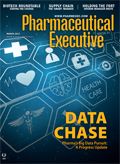Precision Medicine and Big Data
Pharmaceutical Executive
How integrating next-generation sequencing data can advance efforts in immuno-oncology research.
Since the immuno-oncology market is rapidly growing and is projected to reach $34 billion by 2024, the biopharma industry needs to be prepared to take full advantage of this opportunity. To successfully push cancer immunotherapy development forward, drugmakers should use precision medicine approaches in order to manage the complexity of cancer and the heterogeneity of patient populations. In particular, next-
Image: Shutterstock

generation sequencing (NGS) data that characterize tumors and immune systems are crucial to all phases of drug development, from target discovery to clinical trials.
Given the importance of NGS data across development pipelines and portfolios, biopharma companies need to de-silo data storage and analysis throughout their organizations to improve efficiency and productivity. Strategies to achieve this include integrating NGS data in cloud computing environments and deploying data harmonization approaches to make the data useful.
High-value measures
The effective use of NGS data enables innovation during the preclinical stages of drug development. In the discovery phase, genomic data can pinpoint genes or genetic networks of interest. For target identification or validation, genome-wide association studies can demonstrate links between genetic markers and clinical outcomes. Alternatively, genomic data can be directly integrated into a therapeutic approach. For instance, companies developing neoantigen vaccines must tailor the therapy to each patient using their genomic data. Because each individual has a unique repertoire of tumor neoantigens, generating an effective vaccine requires performing DNA sequencing on their tumor and normal cells.
Additionally, biomarkers based on NGS data contribute to the success of immunotherapy clinical trials. A 2016 study released by the Biotechnology Innovation Organization (BIO) showed that using selection biomarkers in clinical trials increased the overall likelihood of drug approval from 8.4% to 25.9%. Biomarkers measured using NGS data can provide a comprehensive picture of a patient’s tumor or immune system; DNA sequencing can measure the tumor mutational landscape or the repertoire of T or B cell receptors, while RNA sequencing can characterize levels of immune signaling molecules in the tumor microenvironment. Such biomarkers can be used to design clinical trials and select participants likely to respond to a therapy. In addition to predicting therapeutic efficacy, these biomarkers can be used throughout a clinical trial to monitor adverse events.

Insights unlocked
As researchers continue to find applications for NGS data across the immunotherapy development pipeline, biopharma executives are faced with the challenge of integrating data access and analysis throughout their companies. Conventionally, biopharma data are siloed in various ways. Independent research divisions each generate NGS data and perform ad hoc analyses on them. Even when data are produced by collaborating teams, silos can arise from physical distance, such as when data are collected at separate clinical trial sites. Additionally, data collected with different methods or formats cannot be readily used together. Although different cancer types were traditionally considered separate silos, researchers are increasingly understanding the similarities between them, including common underlying mutations.
Because NGS data sets can be useful in multiple settings, integrating them across the company eliminates redundancies and inefficiencies. Just as Toyota employed the “Lean” philosophy to reduce waste in their manufacturing processes, biopharma companies can streamline drug development by de-siloing NGS data. This strategy can have a positive impact on all fronts, both within and outside the company.
Integrating NGS data among internal and external research groups prevents redundancy, promotes collaboration, and sparks new discoveries. Establishing a centralized repository of NGS data facilitates access for all internal research groups, regardless of therapeutic area or development phase. In this way, ideas from individual product pipelines can cross-pollinate other areas of the overall portfolio. There can also be feedback between drug development phases; for example, clinical trials can provide patient biomarker data for researchers to mine for new preclinical discoveries. Integrating NGS data storage and analysis also promotes collaboration with external groups, including academic laboratories and contract research organizations (CROs).
By de-siloing NGS data, biopharma executives can help their teams not only manage internal data, but also combine them with public data to make analyses more robust. Massive public genomic data sets such as The Cancer Genome Atlas (TCGA) enable drug discovery. Last year, Loxo Oncology received the FDA breakthrough therapy designation for their drug larotrectinib. The treatment inhibits tropomyosin receptor kinase fusions in metastatic cancers, a molecular target that researchers identified using TCGA data. The discovery power of integrated proprietary data can be extended through analysis alongside massive public data sets.
The cloud connection
Leading biopharma companies are increasingly deploying NGS data storage and computation on the cloud to promote productivity and efficiency. When companies store integrated NGS data in a centralized infrastructure, multiple research groups can access the same data. For example, data collected in multi-center clinical trials can be stored and analyzed in the cloud by all collaborators, preventing costs in redundant storage and time spent transferring data among researchers for analysis. Moreover, researchers can analyze proprietary data stored on the cloud in the context of massive public cancer genomics data sets that are also hosted on cloud environments.
When data analysis tools are brought to the cloud, workflows become reproducible and scalable. If multiple internal research divisions and external groups use the same standardized tools, collaboration and reporting to regulatory bodies become easier. Further, computation on the cloud is elastic; computational resources are optimized and allocated to analyses based on their scale, enabling faster processing.
Because putting NGS data on the cloud does not automatically make them useful, data harmonization strategies are also necessary. Companies should apply data standards across their organization to promote consistent data formatting and labeling. In particular, systematic metadata are key to gaining insights from NGS data. Metadata properties describing sample characteristics such as tumor histology, radiation therapy, and patient demographics must be coordinated before researchers can combine data sets and analyze them together.
Another consideration for data integration is how to effectively operate under different regulations for data transfer and consent. The globalization of drug development means that companies conduct research under multiple regulatory regimes. Understanding them informs strategic decisions, such as in which countries should companies generate and analyze NGS data so that the data can be widely used.
Time to embrace
Biopharma companies must recognize the full potential of NGS data in the field of immuno-oncology. Because NGS data drive innovation ubiquitously throughout the immuno-oncology development pipeline, de-siloing data across the company enables productivity and efficiency. One powerful method to integrate this data is through cloud computing for storage and analysis.
Beyond leveraging cloud technology, it is crucial that a company’s leadership ensures their organizational data harmonization strategies are extracting the most value from their NGS data. Together, these approaches can help the industry deliver on the promise of NGS data and precision immunotherapies.

Brandi Davis-Dusenbery, PhD, is Senior Vice President of Science & Product at Seven Bridges Genomics. She can be reached at brandi@sevenbridges.com

Is Artificial Intelligence a ‘Product’? Products Liability Implications for AI-Based Products
April 10th 2025As the physical products we use evolve to become increasingly complex, traditional products liability frameworks may not always fit to provide remedies for harm that can result from using novel product types.